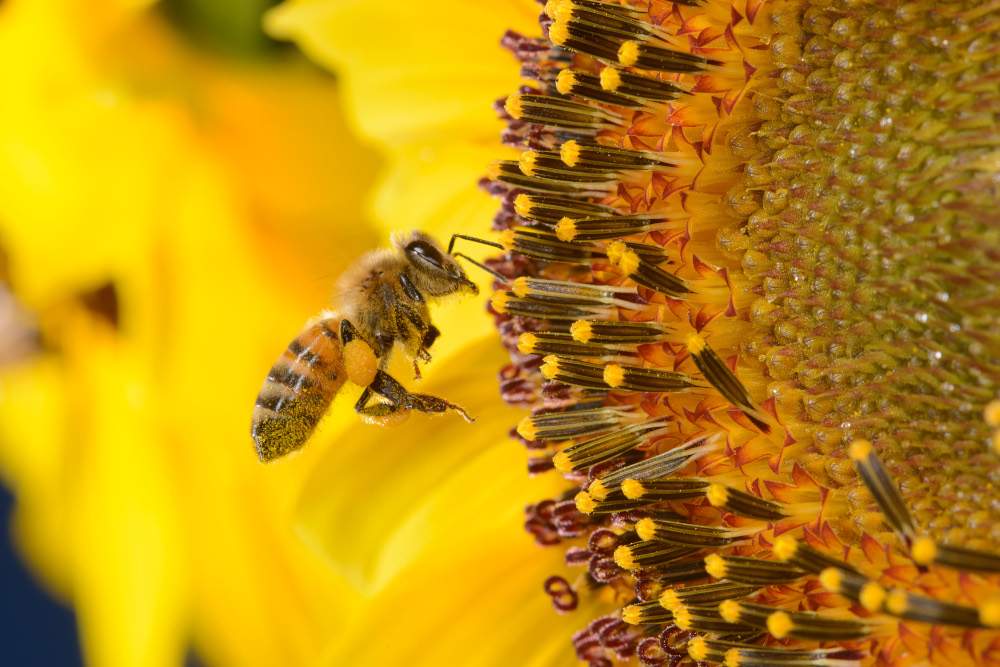On Friday, September 1, at 6 p.m., the MUSE - Trento Science Museum will open the exhibition Cities on a Bee Scale. In search of possible balances, curated by Maria Vittoria Zucchelli, Nicola Orempuller and Luca Mazzocchi, produced in collaboration with the City of Trento, the patronage of the Autonomous Province of Trento and the support of Ricola. Twenty-four panels with photos, insights and multimedia content will tell the story of the universe of social and solitary bees, inspiring good practices to make our cities more welcoming to the tiny insects. The exhibition is embellished with about one hundred shots by photographers Luca Mazzocchi and Nicola Orempuller.
The environments in which we live are increasingly urbanized. Therefore, it is important to create places in harmony with nature. Mazzocchi and Orempuller’s photographs and the insights offered by MUSE aim to invite visitors to discover the fragile world of bees in urban settings and the eco-sustainable actions that can make cities more pleasant not only for us, but also for pollinators. Through a more conscious approach, many cities and metropolises around the world are adopting sustainable urban measures and creating habitats suitable for bees and other pollinators that play a vital role within ecosystems.
The exhibition will be on display in the museum garden until Oct. 15, 2023. An initial focus will be devoted to the importance of urban greenery: in Trento, public greenery occupies an area of about 400 hectares and includes 112 hectares of parks and gardens; 18,400 trees are present; 173,984 square meters are covered by shrubs, isolated, in patches or hedges.
We then turn to the process of pollination and the insects involved in this true “evolutionary miracle.” In fact, it is estimated that about 75 percent of the plants on earth make use of entomophilous pollination, that is, by insects, including lepidopterans (10 percent), beetles (15 percent), dipterans (27 percent) and, above all, hymenopterans (48 percent). Bees belong to the latter category: the exhibition will address habits and peculiarities of social bees and their collective organizational capacity, but also of their cousins, solitary bees, which are less well known but crucial for the protection of biodiversity.
Space will also be given to the ways in which pollen is collected and transported and the challenges to survival that bees and other insects face: climate change, new predators and parasites, and anthropogenic activity, responsible for the spread of pollutants and habitat loss, are the main threats. Hence the importance of fostering and protecting these small animals. The exhibition also aims to be a stimulus to adopt good practices for a new coexistence.
Trento is one of the Bee Friendly Cities, the network of municipalities that has launched a series of initiatives to protect bees and all other threatened pollinators, but each of us can do our part. There are many useful actions to increase the biodiversity present in our gardens, vegetable gardens and terraces: inserting plants and flowers diversified by type and flowering period, making targeted lawn cuts with the intention of leaving small areas uncultivated, placing one or more “insect hotels,” structures capable of providing resting and nesting areas for many of them.
The last section of the exhibition will be dedicated to Citizen Science projects in which all citizens can participate and to the experimental project BeeTrento, promoted by MUSE, the Municipality of Trento, the Free University of Bolzano, the Garden Club Trento, the Trentino Federation of Organic and Biodynamic Agriculture and some urban beekeepers. The collaboration aims to map air quality and botanical biodiversity in the city of Trento through the analysis of pollen collected by honey bees (Apis mellifera), or honey bees, within the urban area. The results of the monitoring will make it possible to collect initial data on the environmental quality of Trent and provide information to the city administration that will be useful in directing future environmental policies.
In addition to the exhibition, two side events are scheduled at MUSE and Gocciadoro Park on Sept. 15 and 16: two days to learn about Italy’s main pollinator groups and the Citizen Science Cross-Polli:Nation project.
Photo Credit: Luca Mazzocchi and Nicola Orempuller.
 |
| An exhibition on bees at MUSE, urging people to protect them |
Warning: the translation into English of the original Italian article was created using automatic tools. We undertake to review all articles, but we do not guarantee the total absence of inaccuracies in the translation due to the program. You can find the original by clicking on the ITA button. If you find any mistake,please contact us.